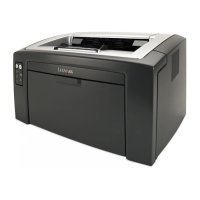2-32 Service Manual
4506-1xx
Paper “trees,” wrinkles, stacks poorly, or curls
Print quality service checks
Note: Ensure the covers are in place. An opening may allow light to expose the photoconductor, resulting in a
‘dirty’ print. Extreme environmental conditions, temperatures, and humidity will affect the print quality.
Using print quality test pages
To help isolate print quality problems, like streaking, print test pages using the print quality test pages.
Model E120
To print the print quality test pages:
1. Enter Diagnostics mode:
a. Turn off the printer.
b. Open the front access cover.
c. Turn on the printer while pressing and holding .
d. When the light stays on, close the cover.
e. Wait (approximately 10 seconds) until the printer drive activates.
2. Press and release .
The Ready/Data light will be on solid.
3. Press and hold until all the lights flash to initiate printing the quality test pages. The error log (history)
will also print.
The first four pages print to help you evaluate print quality. The first page has various fonts, the second
page is gray, the third page is black, and the last page is blank. The following pages list errors and other
printer information.
Use the test pages to isolate problems such as light or toner streaks. The following pages identify solutions for
most print quality problems.
To exit print quality test pages, turn the printer off.
FRU Action
Fuser This problem is most likely due to a worn backup roll. It causes the printer to run
hotter than required for the media being printed. Excessive heat can cause
paper treeing problems, poor stacking, or curl. Replace the fuser. See “Fuser
removal” on page 4-20.
Print the menu sheet (press and release with the printer in ready mode).
Look at the paper settings. Some, such as card stock or rough texture may
require a higher fuser temperature, which leads to more of these problems
(except stacking) in plain paper.
• Change settings using the printer driver.
• Use the local printer setup utility (included on the CD) to change the NVRAM
settings.
Try a different ream of paper. Moist paper has a higher tendency to crease
(treeing) and curl.
A contaminated thermistor can cause the fuser temperature to be elevated. The
fuser has to be removed to determine contamination. A worn or damaged hot roll
can also cause the media to experience a higher temperature than appropriate
for the selected media. Try settings for lower temperature media (light weight,
smooth finish) before replacing the fuser.

